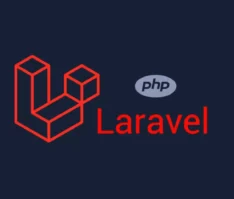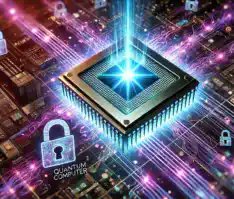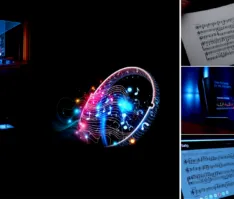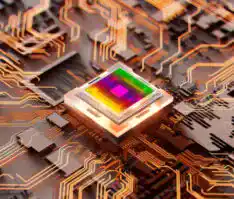Table of Contents
NFTs are unique digital certificates of ownership for digital items or content. This is achieved through blockchain technology. Unlike fungible cryptocurrencies like Bitcoin, NFTs are one-of-a-kind and cannot be directly traded for each other.
Non-fungible tokens (NFTs) are gaining popularity for buying, selling, and trading digital art, collectibles, and virtual real estate. Similar to many cryptocurrencies, they feature unique codes from underlying software, ensuring their status as one-of-a-kind or limited-edition digital assets.
These tokens could revolutionize digital rights management, as they let users own and value intangible digital items. They introduce a new breed of digital collectibles, akin to trading cards or stamps, that collectors can buy to support their favorite companies, brands, games, or artists.
The NFT market has experienced significant growth, with the market value reaching $40 billion in 2021 alone, approaching the total value of the global fine art market. Non-fungible tokens have been around since 2014 but have gained notoriety recently, particularly in the digital art world. They have been praised for their ability to create verifiable ownership and scarcity, making digital assets more collectible and valuable. These tokens can represent various assets digitally, including online-only assets like digital artwork, in-game avatars, collectibles, domain names, and more.
NFTs revolutionize industries like art and gaming. They authenticate ownership innovatively and add value digitally. This groundbreaking technology is reshaping our digital interactions.
NFTs explained simply
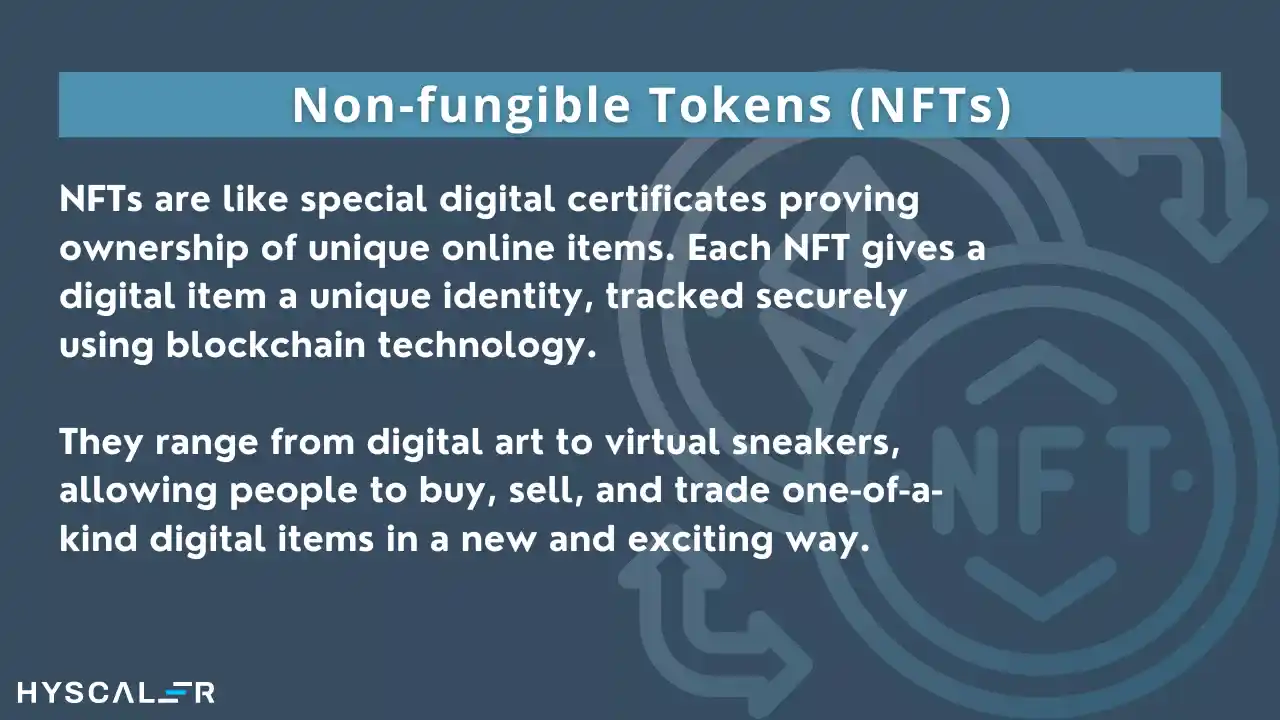
Non-fungible tokens (NFTs) are like digital certificates of ownership for unique items or content. They use blockchain technology to verify and record ownership, making them one-of-a-kind digital assets.
People use these tokens to buy, sell, and trade digital art, collectibles, virtual real estate, and more. They have become popular for their ability to create verifiable ownership and scarcity in the digital world, making digital assets more valuable and collectible.
History of NFTs
NFTs emerged in 2015 and have recently surged in popularity due to various factors. Kevin McCoy and Anil Dash created the first NFT, a unique digital asset. Moreover, NFTs use blockchain technology to confirm ownership and ensure rarity, enhancing the value and appeal of digital assets.
Originally confined to digital art, NFTs now cover a wide range of assets like music, sports highlights, video games, fashion, trading cards, event tickets, memes, domain names, and more. The NFT market has grown quickly, with high-profile sales like Jack Dorsey’s first tweet being sold as an NFT in 2021.
NFTs are commonly unique or from a limited set, each with a different identifying code. They are often traded using cryptocurrencies such as Bitcoin on specialized websites. NFTs adhere to standards like ERC-721 and ERC-1155, which govern the transfer of ownership, methods for confirming transactions, and secure transfer protocols.
The NFT economy first emerged in 2017 with CryptoKitties, a blockchain game that propelled NFTs into popular culture. NFTs have since grown to include various industries like art and gaming, revolutionizing ownership and distribution in the digital landscape. The value of NFT technology is evident in its ability to offer verifiable ownership through cryptography and establish fresh economic systems in diverse sectors.
How NFTs work on the Blockchain
NFTs work on the blockchain by utilizing a distributed public ledger, such as the Ethereum blockchain, to record transactions and verify ownership of unique digital assets. Each NFT contains valuable information stored within it and is secured by the blockchain, ensuring that only one official owner can possess it at a time. Blockchain technology ensures that the record of ownership cannot be altered or duplicated, providing a transparent and secure way to manage ownership of digital assets.
When creating an NFT, a unique asset with specific metadata and identifiers is generated and a smart contract is set up on the blockchain following the ERC-721 standard. The value of an NFT is determined by its uniqueness rather than the effort put into creating it. NFT can represent various digital assets, including art, collectibles, and real estate, and are stored on the blockchain with unique identification codes that distinguish them from each other.
NFTs can be bought, sold, and traded similarly to physical assets, with their value being set by market demand. Blockchain technology ensures the security and transparency of NFT ownership, making it impossible to duplicate or alter the record of ownership. NFTs provide a unique way to tokenize and manage digital assets securely on the blockchain.
How is NFT different from cryptocurrency?
NFTs and cryptocurrencies are both digital assets, but they have important differences. Cryptocurrencies, like Bitcoin, are like regular money that you can exchange for other cryptocurrencies because they are all the same.
Conversely, NFTs stand out as unique digital items. Each holds its special value, making them irreplaceable.
View cryptocurrencies as standard coins, tradable with each other. Meanwhile, view these tokens as rare collectibles, unique and not readily exchangeable.
| Feature | NFT (Non-Fungible Tokens) | Cryptocurrencies |
| Fungibility | Non-fungible – Each NFT is unique and not interchangeable | It is possible to trade one cryptocurrency for another because they are fungible. |
| Value Determination | Value is determined by the uniqueness and market demand | Market supply and demand are the key factors that determine the value of something. |
| Exchangeability | Cannot be exchanged for another NFT easily | Can be traded or swapped for alternative cryptocurrencies |
| Use Case | Represents ownership of unique digital items or content | Utilized for trading purposes or as a method of asset retention. |
| Examples | Digital art, collectibles, virtual real estate | Bitcoin, Ethereum, Litecoin |
NFTs Use Cases
Here are some popular use cases:
- Digital Art: Artists tokenize their digital artwork, enabling them to monetize their creations and reach a global audience of potential buyers. NFTs allow artists to connect directly with their audience and ensure their rights are protected.
- Collectibles like CryptoPunks: They empower a new type of digital collectible, where collectors can purchase unique digital objects like CryptoPunks to show support for specific companies, brands, games, or artists.
- Virtual Real Estate and Metaverse: Tokens representing digital real estate parcels exist on platforms like Decentraland or The Sandbox. These tokens allow users to own virtual land and properties. This creates new opportunities for investment and virtual experiences within the metaverse.
- Sports: The sports industry is embracing these tokens. This technology offers fans unique digital collectibles, engaging experiences, and limited-edition memorabilia. NFTs are enhancing fan engagement with their favorite teams and athletes. In addition, NFTs provide sports organizations with new revenue streams.
- Music: Musicians and artists can tokenize their music, offering fans exclusive digital collectibles, limited editions, and unique experiences, transforming the way music is shared, consumed, and monetized.
- Gaming: In the gaming industry, these tokens enable the creation of non-duplicable in-game assets, such as cosmetic skins, characters, and virtual items. Players can own, trade, and use these NFTs across different games, fostering a new economy within the gaming ecosystem.
How to Buy NFTs
To buy these tokens, follow these steps:
- Setting up a Crypto Wallet: You’ll need a digital wallet to store your NFTs and cryptocurrencies securely. Ensure your wallet supports the currencies accepted by your chosen NFT marketplace.
- Popular NFT Marketplaces: Consider platforms like OpenSea, Rarible, and SuperRare. These marketplaces offer a wide range of NFT collections and artists for you to explore and purchase from.
- Bidding on and Purchasing NFTs: Once you’ve selected an NFT you want to buy, you can place a bid or make a direct purchase, depending on the marketplace’s options. Make sure to follow the platform’s directions to finish the transaction.
- Gas Fees and Transaction Costs: Keep in mind that buying these tokens involves gas fees, which are transaction costs on the blockchain. The pricing can vary depending on the level of congestion on the network and the complexity of the transaction. Be prepared to cover these additional costs when purchasing NFTs.
By following these steps and being aware of gas fees and transaction costs, you can successfully navigate the process of buying NFTs on popular marketplaces like OpenSea, Rarible, and SuperRare.
Selling Your NFTs

To sell your NFTs, follow these steps:
- Creating Your NFT Metadata: First, create metadata for your NFT. This metadata should include details like the title, description, and any other information that makes your digital asset more valuable. This metadata will help potential buyers understand the uniqueness and value of your NFT.
- Minting Your NFT: Mint your NFT to make it purchasable. This involves publishing a unique token linked to your digital asset on the blockchain. NFT marketplaces like OpenSea, Rarible, or SuperRare can help you mint your NFT. Through minting, you create a one-of-a-kind digital asset that can be bought, sold, and traded.
- Listing Your NFT on Marketplaces: Mint your NFT and then list it on marketplaces. This makes it accessible to interested buyers. Ensure you provide accurate information, high-quality visuals, and engaging descriptions to attract buyers to your NFT listing.
- Marketing and Promoting Your NFT: To increase the visibility and sales potential of your NFT, engage in marketing and promotion activities. Then, utilize social media, online communities, and NFT-specific platforms to showcase your NFT, reach a wider audience, and attract potential buyers. Additionally, Collaborate with influencers, participate in NFT drops, and leverage digital marketing strategies to enhance the visibility of your NFT and drive sales.
Follow these steps and market your NFT proactively. You will boost its visibility, draw in buyers, and enhance its sales potential in the bustling NFT market.
The Future of These Tokens
- Mainstream Adoption: NFTs are poised for mainstream adoption as more individuals and industries recognize the value of digital ownership and unique digital assets. With the increasing popularity of these tokens and the growing interest from artists, creators, and collectors, we can expect these tokens to become a common way to buy, sell, and trade digital assets in the future.
- New Use Cases and Innovations: The future of these tokens holds exciting possibilities for new use cases and innovations. From tokenizing real-world assets like real estate and intellectual property to exploring applications in gaming, virtual reality, and decentralized finance, these tokens are expected to revolutionize various industries and create new opportunities for creators and investors alike.
- Legal Considerations and Regulations: As NFTs continue to gain traction, there will be a need for clear legal considerations and regulations to govern the buying, selling, and trading of digital assets. Issues such as intellectual property rights, copyright infringement, and fraud prevention will need to be addressed to ensure a secure and transparent NFT marketplace for all participants.
The future of NFTs is bright. Mainstream adoption, new applications, and legal support are all on the horizon. As NFTs become more integrated, they will transform how we view and use digital assets. This creates exciting opportunities for creators, collectors, and investors in the digital age.
Conclusion
NFTs represent a transformative technology, reshaping how we interact with digital assets. The potential for mainstream adoption, innovative use cases, and continuous innovation fuels NFTs. They stand ready to revolutionize industries and open up exciting opportunities for creators, collectors, and investors.
As NFTs gain traction, we must establish legal considerations and regulations. These measures are crucial for a secure and transparent marketplace. The future promises to be exciting. We can expect a digital landscape driven by unique digital ownership. This ownership will fuel innovation and creativity, creating a whole new way of valuing digital assets.
FAQs
1. What are some examples of these tokens?
Today’s NFTs include Digital Collectible, Domain Names, Games, Essays, and Sneakers in a fashion line. They can represent various digital assets, from online-only assets like digital artwork to real assets like real estate.
2. Are these tokens safe?
Blockchain technology secures NFTs, but users risk losing access if the hosting platform goes bust. It is essential to secure your keys to prevent this from happening.
3. What is the meaning of Non-Fungible?
We call things non-fungible if they are unique and cannot be swapped for something identical because of their special characteristics. These tokens themselves are distinct and irreplaceable assets. Each NFT has unique characteristics and ownership proof stored on a blockchain, which prevents it from being replaced by another token.
4. Should I buy these tokens?
Whether or not you should buy NFTs depends on your risk tolerance and investment goals. Investors consider NFTs risky due to the uncertain future of the market and the lack of historical performance data to inform investment decisions. It’s essential to do thorough research, understand the market, and be cautious before investing in these tokens. Owing to their increasing popularity, NFTs have the potential to become a significant part of the digital economy in the future.
5. Why should people buy these?
People buy NFTs for various reasons. Investors consider NFTs a safe investment option because tokenized assets are accessible to everyone. Buying an NFT empowers you with basic usage rights and grants you the belief that it will hold value in the future.
Additionally, they provide a way of creating verifiable ownership and scarcity, making digital assets more collectible and valuable. These tokens also have the potential to transform the gaming market by creating a new market for virtual assets, enabling players to sell, trade, and buy virtual items with verifiable ownership.
6. How to create and sell these tokens?
To create and sell NFTs, you need to follow these steps:
1. Create a unique asset with distinguishable metadata and identifiers.
2. Set up a smart contract on the blockchain following the ERC-721 standard.
3. Determine the uniqueness of the asset, as the value of an NFT depends on its uniqueness rather than the effort put into creating it.
4. Convert real-world assets into non-fungible tokens if needed.
5. Choose a platform to mint and sell your NFT, such as open marketplaces like OpenSea or proprietary marketplaces.
6. Once minted, promote your NFT through various channels to attract buyers.
7. When selling, ensure you understand the platform fees and any royalties you may receive from secondary sales.
8. Keep track of your NFT sales and engage with the community to build your reputation as an NFT creator.
7. How do NFTs work?
These tokens operate on blockchain technology, specifically on platforms like Ethereum. Each NFT stores valuable information within itself as a unique digital asset. Unlike cryptocurrencies, these tokens are indivisible and cannot be directly exchanged one-for-one.
NFTs are digital certificates of ownership for unique items. These items can be digital artwork, collectibles, or even real-world assets. The blockchain technology verifies that ownership is real. When you buy an NFT, you become the owner of the digital content. In some cases, the original creator gets a share of the sale. There are online marketplaces where people buy and sell these tokens. The value of an NFT depends on how much people want it and how rare it is.
8. What are the key advantages and disadvantages of NFTs?
Advantages:
1. Accessibility: They can be invested in by anyone as they are accessible to all.
2. Efficient Transfer: Global transfer of NFTs is now more efficient and easier.
3. Unique Ownership: They provide verifiable ownership and scarcity, making digital assets more collectible and valuable.
4. New Economic Systems: These tokens have the potential to transform industries like gaming by creating new markets for virtual assets.
Disadvantages:
1. Lack of Regulation: The NFT market is still relatively unregulated, leading to potential scams and fraudulent activities.
2. Market Volatility: The value of these tokens can be highly volatile, making them risky investments.
3. Environmental Impact: These tokens are digital assets that have exploded in popularity. However, there are concerns about the environmental impact of NFTs, especially those created on the Ethereum blockchain. This is because creating and trading these tokens uses a lot of energy.
4. Uncertain Future: The long-term sustainability and mainstream adoption of tokens are still uncertain, posing risks to investors.
9. How to secure your NFTs?
Securing your NFTs is crucial to protect your digital assets. Here are some key steps to enhance the security of these tokens:
1. Use Hardware Wallets: Store your NFTs in hardware wallets for maximum security. These physical devices stay offline, disconnected from the internet, making them much less vulnerable to cyberattacks compared to online wallets.
2, Backup Seed Phrases: If you choose to use a hardware wallet, ensure you back up your seed phrase securely. Losing your seed phrase can result in permanent loss of access to your NFTs.
3. Research NFT Exchanges: Before buying these tokens, research how to keep your information and cryptocurrency safe. Choose reputable NFT exchanges and read online guides and reviews to understand the market and associated risks.
4. Secure Digital Wallets: Transfer your purchased tokens to a secure digital wallet. The process may vary depending on the exchange, wallet, and marketplace you use for trading NFTs.
By following these security measures, you can safeguard your NFT investments and minimize the risk of unauthorized access or loss of your digital assets.
10. What is the process of buying tokens?
The process of buying NFTs involves the following steps:
1. Open a Crypto Exchange Account: The first step is to open an account on a crypto platform or exchange where you can buy and sell cryptocurrencies. To ensure a secure and efficient experience, it’s important to choose the best cryptocurrency exchange that aligns with your preferences and offers a wide range of supported cryptocurrencies.
2. Acquire a Digital Wallet: You’ll need a digital wallet that allows you to store your NFTs and cryptocurrencies securely. Ensure your wallet supports the specific cryptocurrencies accepted by your chosen NFT provider.
3. Purchase Cryptocurrency: Depending on the currencies accepted by the NFT provider, you may need to purchase specific cryptocurrencies like Ether (ETH). You can buy cryptocurrencies using platforms like Coinbase, Kraken, eToro, PayPal, or Robinhood.
4. Select an NFT Marketplace: First, you’ll want to choose an NFT marketplace to explore. Popular options include OpenSea, SuperRare, and Rarible. Then, it’s important to remember that most They are purchased using Ether (ETH). This means you’ll need to have Ether in your digital wallet before you can buy these tokens.
5. Complete the Purchase: Once you’ve selected the NFT you want to buy, follow the marketplace’s instructions to complete the purchase. Ensure you understand any fees associated with the transaction and securely store your newly acquired NFT in your digital wallet.
By following these steps, you can successfully navigate the process of buying NFTs and start building your digital asset collection.


